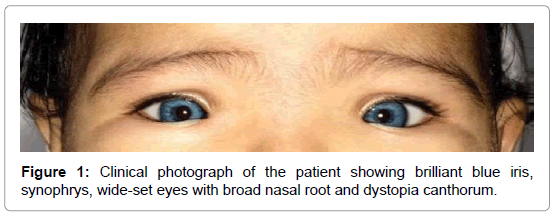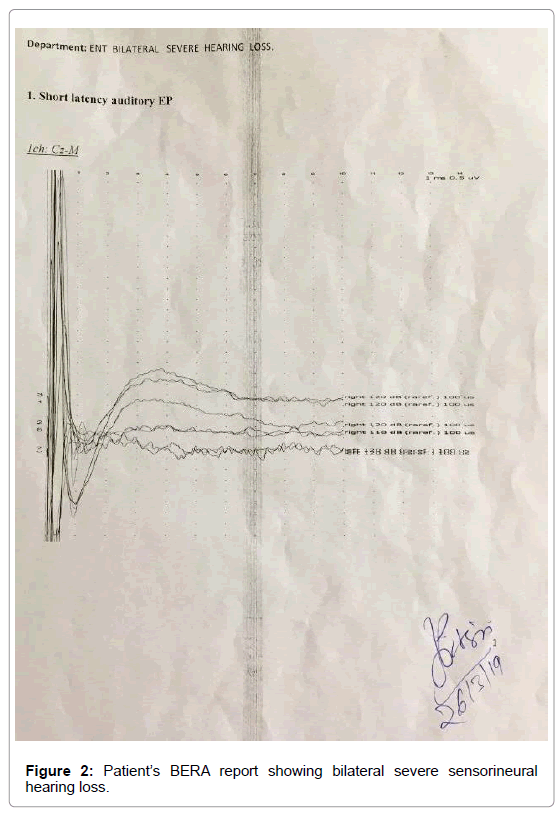Waardenburg Syndrome Type I: An Otorhinolaryngologist's Perspective
Received: 08-Sep-2019 / Accepted Date: 31-Oct-2019 / Published Date: 07-Nov-2019 DOI: 10.4172/2161-119X.1000383
Abstract
Waardenburg syndrome type I is a rare, autosomal dominant auditory-pigmentary syndrome characterized by congenital sensorineural hearing loss, pigmentary abnormalities of the iris, hair and skin, and dystopia canthorum. Waardenburg syndrome affects an estimated 1 in 40,000 people. It accounts for 2 to 5 percent of all cases of congenital hearing loss. Here, we present the case of an 11-month old girl with Waardenburg syndrome type I.
Keywords: Waardenburg syndrome type I; Sensorineural hearing loss; Blue iris; Dystopia canthorum
Introduction
Auditory-pigmentary syndromes refer to a group of syndromes characterized by physical absence of melanocytes from the skin, hair, eyes or the stria vascularis of the cochlea, due to abnormalities in the development of neural crest and its derivatives. Waardenburg syndrome is a group of autosomal dominant inherited genetic conditions that can cause hearing loss and changes in coloring (pigmentation) of the hair, skin, and eyes. Although most people with waardenburg syndrome have normal hearing, moderate to profound hearing loss can occur in one or both ears. Waardenburg syndrome is named after Petrus J Waardenburg, a Dutch ophthalmologist and geneticist, who first described the syndrome now known as waardenburg syndrome type I. Waardenburg estimated that this syndrome was prevalent in 1/42,000 of the general population and in 1.43% of the congenitally deaf [1].
Case Report
An 11-month-old female child was brought to the out-patient department of the Dept. of Otorhinolaryngology, Gauhati Medical College and Hospital by her parents, who complained that the child did not turn towards source of sounds, nor was she able to vocalise words. The child was born to parents with no history of consanguineous marriage. She was born via normal vaginal delivery in hospital with adequate birth weight. Her perinatal and neonatal periods were uneventful. Her mother did not suffer from any diseases during the ante-natal period. Her developmental milestones were appropriate for her age. There was no history of constipation or persistent vomiting. Family history was unremarkable. Her vitals and general physical examination were normal and did not reveal any limb abnormalities. Local examination revealed brilliant blue iris, synophrys, wide-set eyes with broad nasal root and dystopia canthorum (W index=2.76) (Figure 1). Brain-stem evoked response audiometry revealed bilateral severe sensorineural hearing loss (Figure 2). High resolution computerized tomography scans of the patient’s temporal bones were carried out and they did not reveal any congenital or acquired pathology of the ear (Figure 3).
Discussion
Waardenburg syndrome is an auditory-pigmentary syndrome characterized by congenital sensorineural hearing loss, pigmentary anomalies of the hair such as a white forelock and premature greying, and pigmentary changes of the iris such as brilliant blue iris and heterochromia irides–complete heterochromia iridium or partial/ segmental heterochromia. It is inherited as an autosomal dominant trait. Waardenburg syndrome has been classified into four main phenotypes. Characteristic features of type I and type II have been described in [2,3] (Table 1). Type III, also known as Klein-Waardenburg syndrome has, in addition to type I characteristics, hypoplasia of the limb muscles, contracture of elbows and fingers and mental disabilities [4]. Type IV, also known as Shah-Waardenburg syndrome presents with Hirschsprung’s disease in addition to the manifestations exhibited in type II [5]. Temporal bone anomalies associated with Waardenburg syndrome, such as enlargement of the vestibular aqueduct and upper vestibule, narrowing of the internal auditory canal porus and hypoplasia of the modiolus [6], are mostly seen with type 2 and type 4.
| Diagnostic criteria for WS1 have been proposed by the Waardenburg Consortium [2]. In brief, to be counted as affected, a person must have two major or one major plus two minor criteria from the following list: |
| Major Criteria: • Congenital sensorineural hearing loss • Pigmentary disturbances of iris • Hair hypopigmentation – white forelock • Dystopia canthorum–lateral displacement of ocular inner canthi, W index >1.95 • Affected first degree relative |
| Minor Criteria: • Congenital leukoderma–several areas of hypopigmented skin • Synophyrys or medial eyebrow flare • Broad and high nasal root • Hypoplasia of alae nasi • Premature greying of hair–scalp hair predominantly white before age 30 years. |
| Criteria for WS2 were suggested by Liu et al. [3]. These authors recommended that two major features should be present to make the diagnosis of WS2. The major features are as in the list above, except for the exclusion of dystopia canthorum and inclusion of premature greying |
Table 1: Diagnostic criteria for Waardenburg syndromes type I and II.
Multiple genes are implicated in waardenburg syndrome. Abnormalities in the paired box gene 3 (PAX3), a transcription factor located on chromosome 2q35, accounts for most of the WS1 and WS3 patients [7]. PAX3 plays a major role in embryogenesis. WS1 is inherited in an autosomal dominant manner, with majority of the probands having an affected parent. There may also be de novo mutation, as minority of the probands do not have affected parents [8]. In our case, the PAX3 gene sequence and duplication/deletion analysis could not be performed, but it appears to be a case of de novo mutation as the patient has healthy parents and family members.
No specific treatment is available and management is aimed towards the specific symptoms that are apparent in each individual. Early recognition of sensorineural deafness, which is congenital, typically non-progressive and may be either unilateral or bilateral, plays an important role in ensuring prompt intervention. Prompt diagnosis and appropriate supportive management is beneficial for the child’s physical and mental development. Hearing deficit may be corrected by using hearing aids, proper schooling, as well as by doing cochlear implantation [9]. In addition, early, special instructions such as sign language, lip reading, use of communication devices etc, may be recommended to assist in the development of speech and to aid in communication. Genetic counselling, special education and/or other medical, social or occupational services maybe beneficial for the affected individuals and their family members.
Conclusion
In conclusion, with the presence of bilateral severe hearing loss, brilliant blue iris, synophyrys, wide-set eyes with broad nasal root and dystopia canthorum, we can diagnose our case as Waardenburg Syndrome Type I.
Consent
Written and informed consent was obtained from the patient’s legal guardian regarding the use of the patient’s picture and the reports of the investigations that were conducted.
Conflict of Interest
The authors declare no conflicts of interest during the course of the making of this paper.
References
- Waardenburg PJ (1951) A new syndrome combining developmental anomalies of the eyelids, eyebrows and nose root with pigmentary defects of the iris and head hair and with congenital deafess. Am J Hum Genet 3: 195-253.
- Farrer LA, Grundfast KM, Amos J, Arnos KS, Asher JH Jr, et al. (1992) Waardenburg syndrome (WS) type 1 is caused by defects at multiple loci, one of which is near ALPP on chromosome 2: first report of the WS Consortium. Am J Hum Genet 50: 902-913.
- Liu XZ, Newton VE, Read AP (1995) Waardenburg syndrome type 2: phenotypic findings and diagnostic criteria. Am J Med Genet 55: 95-100.
- Klein D (1983) Historical background and evidence for dominant inheritance of the Klein-Waardenburg syndrome (type II). Am J Med Genet 14: 231-239.
- Shah KN, Dalal SJ, Desai MP, Sheth PN, Joshi NC, et al. (1981) White forelock, pigmentary disorder of irides, and long segment Hirschsprung disease: Possible variant of Waardenburg syndrome. J Pediatr 99: 432–435.
- Madden C, Halsted M, Hopkin R, Choo D, Benton C, et al. (2010) Temporal bone abnormalities associated with hearing loss in waardenburg syndrome. Laryngoscope. 113: 2035-2041.
- Eigelshoven S, Kameda G, Kortüm AK, Hübsch S, Angerstein W, et al. (2009) Waardenburg syndrome type I with heterochromia iridis and circumscribed hypopigmentation of the skin. Pediatr Dermatol 26: 759-761.
- Milunsky JM (2009) Waardenburg syndrome. In: Pagon RA, Bird TD, Dolan CR, Stephens K (eds) GeneReviews. Seattle (WA), University of University of Washington, Seattle, USA.
- Cullen R D, Zdanski C, Roush P, Brown C, Teagle H, et al. (2006) Cochlear implants in Waardenburg syndrome. Laryngoscope 116: 1273–1275.
Citation: Goswami A, Sharma K (2019) Waardenburg Syndrome Type I: An Otorhinolaryngologist’s Perspective. Otolaryngol (Sunnyvale) 9: 383. DOI: 10.4172/2161-119X.1000383
Copyright: © 2019 Goswami A, et al. This is an open-access article distributed under the terms of the Creative Commons Attribution License, which permits unrestricted use, distribution, and reproduction in any medium, provided the original author and source are credited.
Select your language of interest to view the total content in your interested language
Share This Article
Recommended Journals
Open Access Journals
Article Tools
Article Usage
- Total views: 5156
- [From(publication date): 0-2019 - Dec 23, 2025]
- Breakdown by view type
- HTML page views: 4287
- PDF downloads: 869



